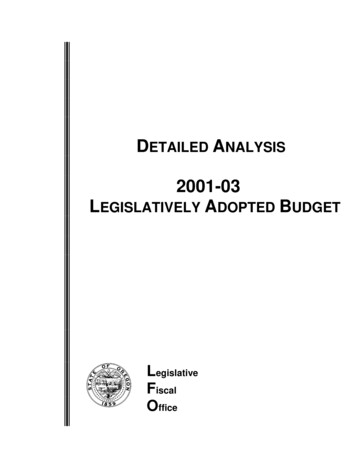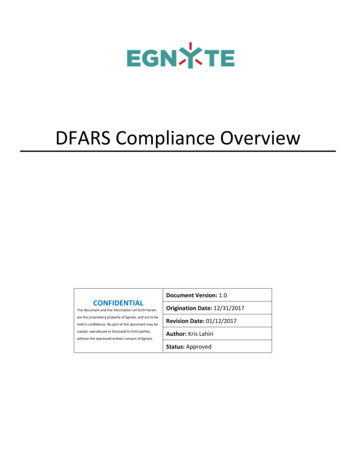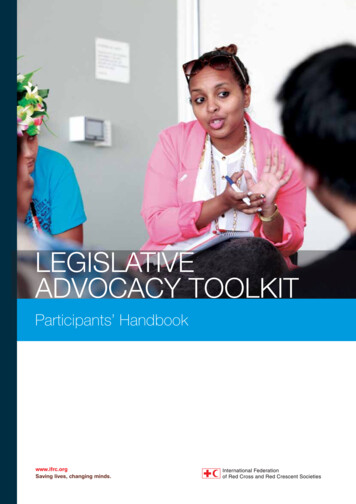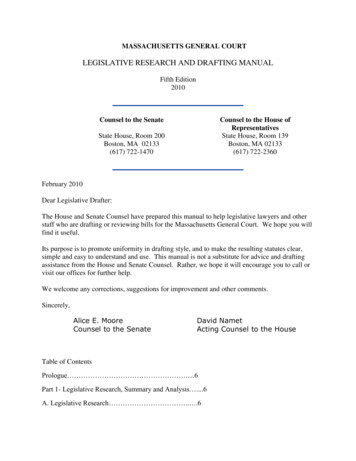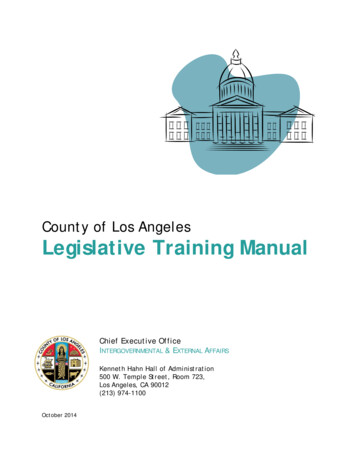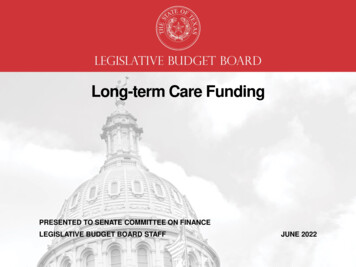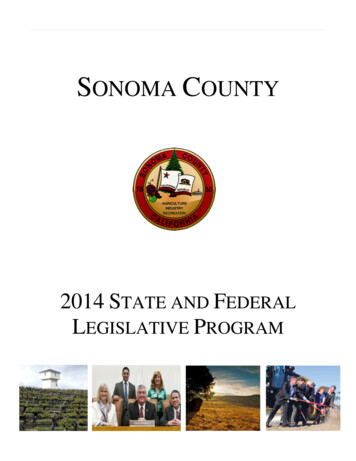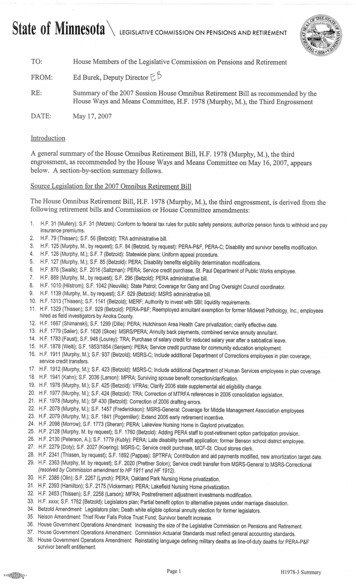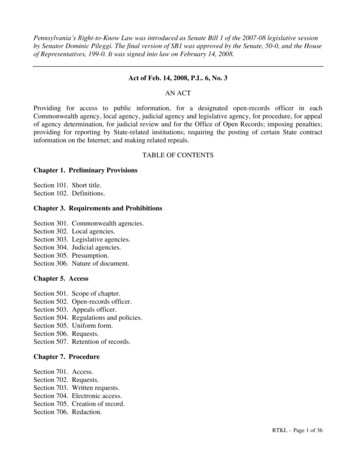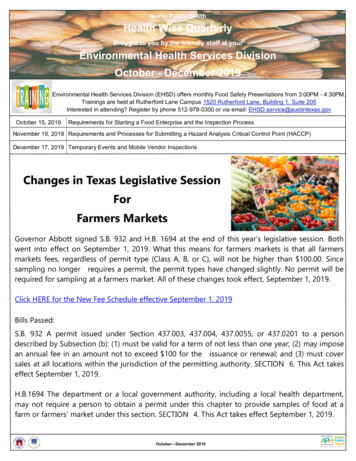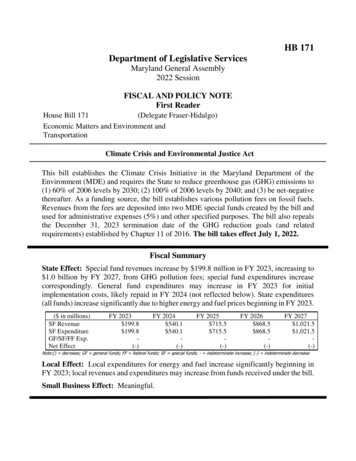
Transcription
HB 171Department of Legislative ServicesMaryland General Assembly2022 SessionFISCAL AND POLICY NOTEFirst ReaderHouse Bill 171(Delegate Fraser-Hidalgo)Economic Matters and Environment andTransportationClimate Crisis and Environmental Justice ActThis bill establishes the Climate Crisis Initiative in the Maryland Department of theEnvironment (MDE) and requires the State to reduce greenhouse gas (GHG) emissions to(1) 60% of 2006 levels by 2030; (2) 100% of 2006 levels by 2040; and (3) be net-negativethereafter. As a funding source, the bill establishes various pollution fees on fossil fuels.Revenues from the fees are deposited into two MDE special funds created by the bill andused for administrative expenses (5%) and other specified purposes. The bill also repealsthe December 31, 2023 termination date of the GHG reduction goals (and relatedrequirements) established by Chapter 11 of 2016. The bill takes effect July 1, 2022.Fiscal SummaryState Effect: Special fund revenues increase by 199.8 million in FY 2023, increasing to 1.0 billion by FY 2027, from GHG pollution fees; special fund expenditures increasecorrespondingly. General fund expenditures may increase in FY 2023 for initialimplementation costs, likely repaid in FY 2024 (not reflected below). State expenditures(all funds) increase significantly due to higher energy and fuel prices beginning in FY 2023.( in millions)SF RevenueSF ExpenditureGF/SF/FF Exp.Net EffectFY 2023 199.8 199.8(-)FY 2024 540.1 540.1(-)FY 2025 715.5 715.5(-)FY 2026 868.5 868.5(-)FY 2027 1,021.5 1,021.5(-)Note:() decrease; GF general funds; FF federal funds; SF special funds; - indeterminate increase; (-) indeterminate decreaseLocal Effect: Local expenditures for energy and fuel increase significantly beginning inFY 2023; local revenues and expenditures may increase from funds received under the bill.Small Business Effect: Meaningful.
AnalysisBill Summary:Greenhouse Gas Reduction Goals and PlanThe bill requires the State to increase the rate at which GHG emissions must be reducedfrom 2006 levels. By December 31, 2022, MDE must adopt a final plan that reducesstatewide GHG emissions by 60% from 2006 levels by 2030. MDE must also monitorimplementation of the plan and report to the Governor and the General Assembly byDecember 31, 2022 (and every three years thereafter) on the State’s progress towardachieving the reductions in GHG emissions required and the GHG emissions reductionsneeded by 2050 to avoid dangerous climate changes, as specified.Additionally, the Secretary of the Environment, in coordination with the Climate CrisisCouncil (established by the bill), must develop a plan to achieve the GHG emissionsreduction targets established by the bill. The bill establishes provisions regarding thedevelopment of the plan and any amendments to the plan; among other things, prior to thesubmission of the plan, an independent and respected entity must verify through modelingthat the plan will (1) meet the GHG reduction targets and (2) be equitable. The Secretarymust submit the plan to the General Assembly by December 31, 2022.Climate Crisis Initiative – GenerallyThe Climate Crisis Initiative provides for: the establishment of GHG reduction goals;the establishment of a Climate Crisis Council;the assessment of GHG pollution fees;benefits to households and employers in the State to mitigate the impact of feesunder the initiative; andthe funding of activities for GHG reduction and sequestration, improvements inresiliency, and the promotion of a just economic transition in the State.The Secretary of the Environment must (1) administer the schedule of GHG pollution feesand (2) delegate the collection of the fees, the distribution of benefits, and any otherappropriate functions to the Comptroller.The bill establishes several other requirements for MDE, the Comptroller, the PublicService Commission (PSC), the Department of Human Services, the Department ofCommerce, the Maryland Department of Labor, the Department of Housing andHB 171/ Page 2
Community Development, and the Commission on Environmental Justice and SustainableCommunities, including several reporting requirements, consultation on various aspects ofthe initiative, and the adoption of regulations.Greenhouse Gas Pollution FeesThe bill establishes a fee on all fossil fuels brought into the State for combustion in theState. The fees are calculated based on relevant carbon dioxide- (CO2) equivalentemissions, subject to related requirements, and with various exclusions and reductions, asspecified.GHG pollution fees begin July 31, 2022, for nontransportation fuels and July 31, 2023, fortransportation fuels, as specified; the fees increase each year until 2032, at which point theystay level. For nontransportation fuels, the fee starts at 15 per ton of CO2 equivalent andincreases to 60 per ton of CO2 equivalent in 2032 and each year thereafter. Fortransportation fuels, the fee starts at 10 per ton of CO2 equivalent and increases to 37 per ton of CO2 equivalent in 2032 and each year thereafter. The bill specifies that thesefees may not be passed through as a direct cost to (1) an end user of a fossil fuel or (2) acustomer of a gas company. However, that general prohibition does not prohibit a gascompany from passing through such a fee on the commodity distributed to a customer tothe extent that PSC approves the fee as a prudently incurred cost of distribution. The feesmust be collected as the first point of sale of the fossil fuel in the State and paid by theentity transporting the fossil fuel into the State.The collection of the fee must begin upon the adoption of all rules necessary for collection,but not later than January 1, 2024, for emissions occurring in the second half of 2023. Ifthe fees take effect in a calendar year later than 2023, the Secretary of the Environmentmust delay the fee schedule described above, as specified.Fee Revenue DistributionsRevenues from the fees are deposited into the Household and Employer Benefit Fund andthe Climate Crisis Infrastructure Fund, as discussed further below. Each fund isadministered by MDE, may be used for administrative costs, and must be used for specifiedpurposes. MDE must consult with the Climate Crisis Council in administering theInfrastructure Fund. The Benefit Fund and the Infrastructure Fund each receive 50% of thetotal GHG pollution fee revenue.Household and Employer Benefit FundThe Household and Employer Benefit Fund, in addition to any other funds, consists of50% of the total GHG pollution fee revenue. The stated purposes of the fund are toHB 171/ Page 3
(1) provide a high degree of protection for low- and moderate-income households in theState and (2) protect energy intensive trade-exposed employers in the State. Generally, thefund must be used to pay benefits, for which there are two separate accounts: (1) theHousehold Benefit Account, which consists of 80% of the money in the fund; and (2) theEmployer Benefit Account, which consists of 20% of the money in the fund. Money mustbe distributed through the two benefit accounts to households and employers, subject tovarious requirements, exclusions, and potential timing changes, as specified. Leftoverfunds are transferred to the Infrastructure Fund.Money distributed from the Household Benefit Account is not taxable income and, to theextent feasible, must be excluded from household income for the purposes of determiningeligibility for, or the level of, any form of public assistance.Climate Crisis Infrastructure FundThe Climate Crisis Infrastructure Fund, in addition to any other funds, consists of (1) 50%of the total GHG pollution fee revenue and (2) any remaining unspent benefits receivedfrom the Benefit Fund. The stated purpose of the fund is to invest in initiatives that improvethe health and welfare of the citizens of the State for specified purposes generally relatedto clean energy and resiliency. When feasible, investments must also be designed to createlocal economic development and employment in the State. At least 50% of the money mustbe invested in projects that are located within and provide meaningful benefits toenvironmental justice populations. Additionally, up to 50% of the money may be disbursedto qualified county and municipal governments for qualifying projects; the Climate CrisisCouncil, in consultation with the Commission on Environmental Justice and SustainableCommunities, must establish and publish the qualification criteria, as specified. Up to 5%of the money in the fund may also be used to provide technical assistance, capacity, andplanning tools to local governments, as specified.Current Law: A “carbon dioxide equivalent” is the measurement of a given weight ofGHG that has the same global warming potential, measured over a specified period of time,as one metric ton of CO2.The Greenhouse Gas Emissions Reduction Act (GGRA), originally enacted in 2009 andmade permanent and expanded in 2016, was enacted in light of Maryland’s particularvulnerability to the impacts of climate change and is the State’s primary statutory guide toaddressing climate change. Under the Act, the State must develop plans, adopt regulations,and implement programs to reduce GHG emissions by 25% from 2006 levels by 2020 andmust further reduce GHG emissions by 40% from 2006 levels by 2030; the 2030 reductionrequirement terminates December 31, 2023.HB 171/ Page 4
Pursuant to GGRA, by October 1, 2022, MDE must report on the progress towardachieving the 2030 reductions as well as the reductions needed by 2050 to avoid the mostdangerous impacts of climate change, as specified. MDE is also required to review andpublish an updated statewide GHG emissions inventory every three years. MDE releasedits final 2030 GGRA Plan in February 2021.The Healthy Air Act of 2006 established emission limits for nitrogen oxides, sulfur dioxide,and mercury from specified electric generating facilities in the State. The Act alsoaddressed CO2 emissions by requiring the Governor to include the State in the RegionalGreenhouse Gas Initiative, a cap-and-trade program established in conjunction with othernortheastern and mid-Atlantic states. Each state limits CO2 emissions from electric powerplants, issues CO2 allowances, and establishes participation in CO2 allowance auctions. Asingle CO2 allowance represents a limited authorization to emit one ton of CO2.State Fiscal Effect:Greenhouse Gas Pollution Fees and Associated ExpendituresSpecial fund revenues from the GHG pollution fees increase by an estimated 199.8 million in fiscal 2023, increasing to more than 1.0 billion by fiscal 2027, as shownin Exhibit 1. Revenues continue to increase in future years as fees increase, althoughrevenues may eventually decrease once fees have leveled off. This estimate is based on theincreasing GHG pollution fees established by the bill (beginning July 31, 2022, fornontransportation fuels and July 31, 2023, for transportation fuels). Adjustments are madefor a calendar year to fiscal year conversion.The estimate does not reflect any fee reductions for emissions compliance cost obligationsfor petroleum products under regional initiatives. The estimate also does not include anyrevenues from escaped/released methane. To the extent that the collection of fees isdelayed, special fund revenues and expenditures are similarly delayed.HB 171/ Page 5
Exhibit 1Revenue Generated by the Fees and the Allocation of FundsFiscal 2023-2027( in Millions)FY 2023 FY 2024 FY 2025 FY 2026FY 2027 199.8 540.1 715.5 868.5 1,021.5Benefits FundAdministrative Costs*5%Available for Programmatic Uses 95% 99.95.094.9 270.013.5256.5 357.717.9339.8 434.221.7412.5 510.825.5485.2Infrastructure FundAdministrative Costs*5%Available for Programmatic Uses 95% 99.95.094.9 270.013.5256.5 357.717.9339.8 434.221.7412.5 510.825.5485.2Total Fees Collected* Each fund is authorized to use up to 5% of revenues for administrative costs. To the extent thatadministrative costs are less, available programmatic funds increase. Revenues from all fees are split 50/50between the Benefit Fund and the Infrastructure Fund. Numbers may not sum to total due to rounding.Source: Department of Legislative ServicesFor the purposes of this fiscal and policy note, it is assumed that all revenues collectedfrom the GHG pollution fees are expended in the same year they are received. As a result,special fund expenditures increase correspondingly. It is further assumed that fees arecollected beginning July 31, 2022. However, it is likely that both the collection of GHGfees and any corresponding increase in expenditures are delayed, at least initially as theinitiative is fully established.As noted earlier, up to 5% of the money in each fund may be used for administration. Dueto many unknown factors, the total administrative costs to implement the initiative cannotbe reliably estimated at this time, as discussed below. However, Exhibit 1 shows theamounts available for projects/benefits in each fund assuming the full 5% is used to coveradministrative costs.This analysis assumes that these expenditures are sufficient to meet the enhanced GHGemissions reduction requirements established under the bill. To the extent this is not thecase, State expenditures further increase.HB 171/ Page 6
Administrative Costs for MDE and the ComptrollerThe bill authorizes the use of special funds to cover administrative costs, and the intentionis for fees to be collected beginning July 31, 2022. However, it is likely that that MDE andthe Comptroller incur costs prior to collecting any fees. Thus, it is assumed that somegeneral funds are needed to initially cover costs prior to special funds being made availablefor repayment in fiscal 2024. A reliable estimate of any general funds needed in fiscal 2023cannot be made at this time.MDE is broadly responsible for administering the schedule of fees but must delegate thecollection of fees, the distribution of benefits, and any other appropriate functions to theComptroller. The combined administrative costs as estimated by MDE and the Comptrollerrange from approximately 9.1 million to 11.6 million annually, reflecting informationtechnology costs and the need for roughly 100 staff; however, both agencies haveexpressed significant difficulties in determining costs associated with administration. Costsare substantial due to the breadth of the affected entities, the complex system of fees andbenefits established by the bill, and the overall amount of funds being administered. Dueto these complexities, this analysis assumes that all 5% of available funding foradministrative costs is used by MDE and the Comptroller. To the extent that less is spenton administrative costs, more funding is available each year for programmatic purposes.Other AgenciesIt is assumed that the various agencies identified in the bill that have administrativeresponsibilities not discussed above can handle the bill’s requirements with existingbudgeted resources. To the extent this is not the case, State expenditures further increase.State Expenditures for Gas/Electricity and FuelAs noted above, the bill specifies that, generally, GHG pollution fees may not be passedthrough as a direct cost to (1) an end user of a fossil fuel or (2) a customer of a gas company.Despite this general prohibition, the bill still increases production costs in the energy sector,which will affect commodity output and/or prices as the affected companies seek tomaximize revenues: output will likely fall, and prices will likely rise. Further, specific tonatural gas, the bill does not prohibit the passing through of the GHG pollution fees to theextent that PSC approves the fee as a prudently incurred cost of distribution. Therefore,State expenditures (all funds) increase significantly beginning in fiscal 2023 due to higherenergy and fuel prices.HB 171/ Page 7
To the extent any State agencies, as employers, receive any benefits from theEmployer Benefit Account, or receive funds from the Infrastructure Fund, some portion ofthe anticipated increase in expenditures may be offset.Local Fiscal Effect: Local government expenditures increase significantly beginning infiscal 2023 due to higher energy fuel prices, for the reasons discussed above. To the extentany local governments, as employers, receive any benefits from the Employer BenefitAccount, or receive funds from the Infrastructure Fund, some portion of the anticipatedincrease in expenditures may be offset. Local governments may also benefit from technicalassistance, capacity, and planning tools provided under the Infrastructure Fund.Small Business Effect: Small businesses throughout the State incur a significant increasein expenditures due to higher energy and fuel prices for the reasons discussed above. Asemployers, however, some small businesses are slated to receive benefits under the bill. Inaddition, small businesses that provide services and products related to reducing GHGemissions likely see a meaningful increase in the demand for their services as a result ofthe significant funding available for these types of projects under the bill.Additional InformationPrior Introductions: SB 76 of 2021, a similar bill, received a hearing in the Senate Budgetand Taxation Committee, but no further action was taken. Its cross file, HB 33, receivedan unfavorable report from the House Economic Matters Committee. SB 912 of 2020, asimilar bill, received a hearing from the Senate Budget and Taxation Committee, but nofurther action was taken. Its cross file, HB 1543, received a hearing from the HouseEconomic Matters Committee, but no further action was taken. Similar legislation was alsointroduced during the 2019 and 2018 legislative sessions.Designated Cross File: SB 135 (Senator Kramer) - Education, Health, and EnvironmentalAffairs and Budget and Taxation.Information Source(s): Baltimore City; Harford and Montgomery counties; City ofCollege Park; Maryland Municipal League; Department of Commerce; Comptroller’sOffice; Judiciary (Administrative Office of the Courts); Public School ConstructionProgram; Maryland Department of the Environment; Department of General Services;Department of Housing and Community Development; Maryland Department of Labor;Department of Natural Resources; Department of Public Safety and Correctional Services;Maryland Department of Transportation; Office of People’s Counsel; Public ServiceCommission; U.S. Energy Information Administration; Department of Legislative ServicesHB 171/ Page 8
Fiscal Note History:js/lgcFirst Reader - February 11, 2022Analysis by: Kathleen P. KennedyHB 171/ Page 9Direct Inquiries to:(410) 946-5510(301) 970-5510
HB 171/ Page 2 Bill Summary: Greenhouse Gas Reduction Goals and Plan The bill requires the State to increase the rate at which GHG emissions must be reduced from 2006 levels. By December 31, 2022, MDE must adopt a final plan that reduces statewide GHG emissions by 60% from 2006 levels by 2030. MDE must also monitor
